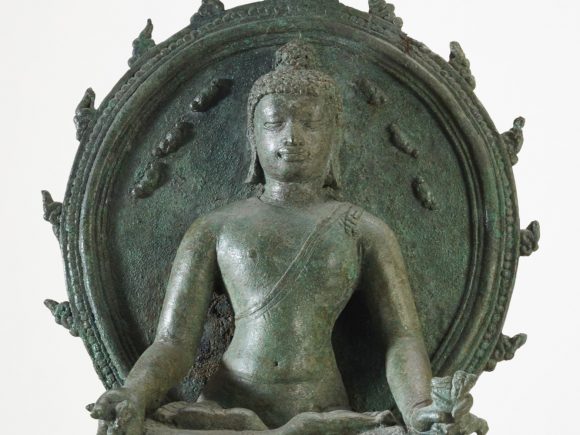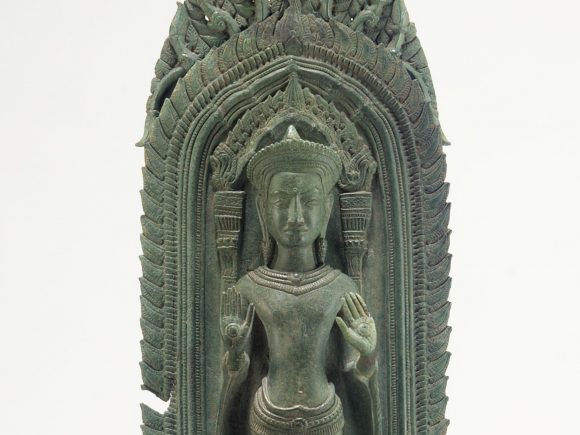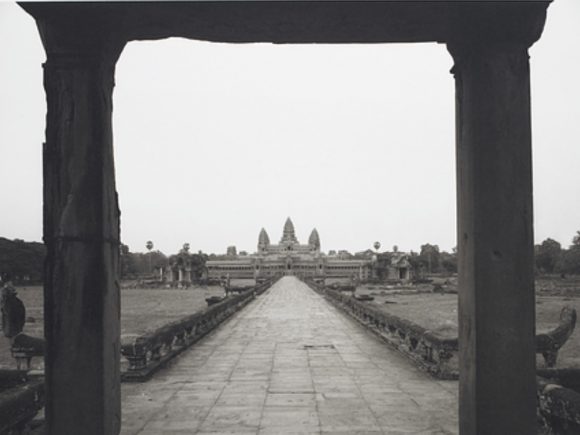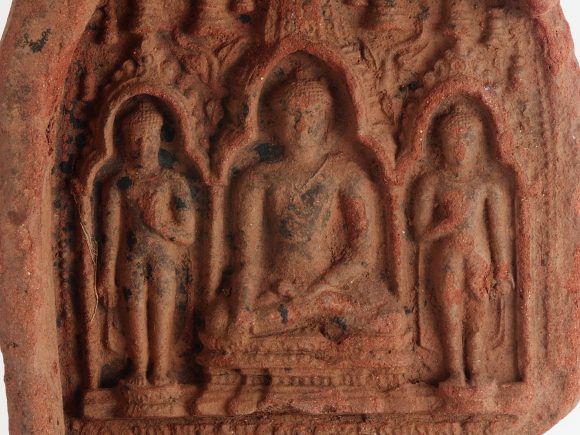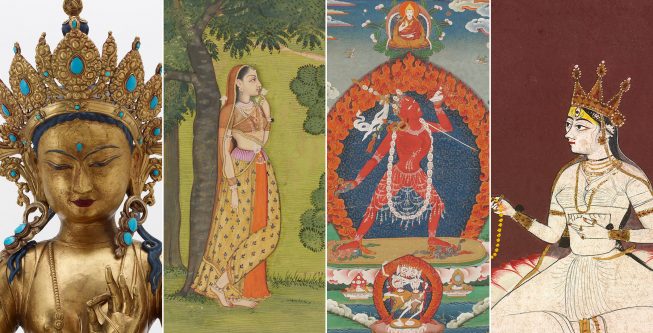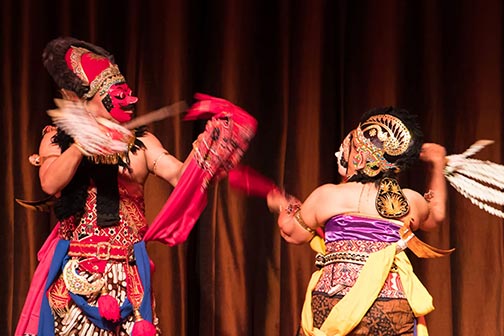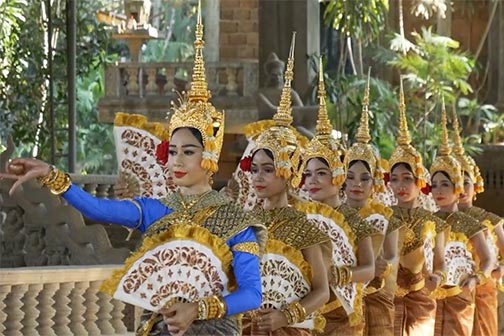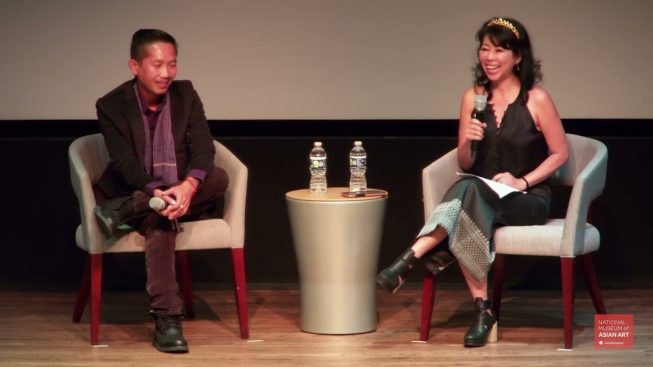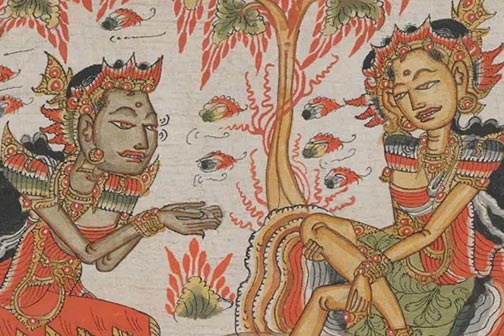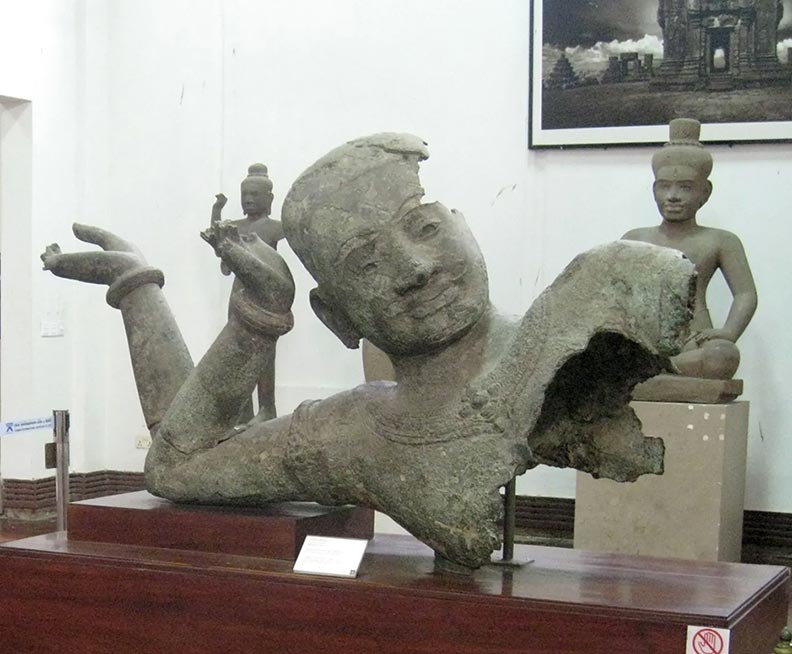Southeast Asian art history and archaeology are burgeoning fields of study. Although much of the foundational scholarship was written during the colonial period (early twentieth century), exciting new research is expanding our understanding of the region as a well-networked epicenter of culture and history. Browse resources that highlight these findings.
Smithsonian Publications | Southeast Asia (General) | Cambodia | Indonesia | Laos | Malaysia | Myanmar (Burma) | Philippines | Thailand | Vietnam
Smithsonian Publications
Objects in the National Museum of Asian Art’s Southeast Asia collections have played important roles in major exhibitions and publications. Peruse National Museum of Asian Art publications below.
Farhad, Massumeh, and Sana Mirza, eds. Global Lives of Objects: Celebrating 100 Years of the National Museum of Asian Art. Washington, DC: National Museum of Asian Art, Smithsonian Institution, 2023.
Paths to Perfection: Buddhist Art at the Freer|Sackler (2017)
Performing Indonesia (2016, Online Publication)
Cort, Louise, and Paul Jett, eds. Gods of Angkor: Bronzes from the National Museum of Cambodia. Washington, DC: Arthur M. Sackler Gallery, Smithsonian Institution, 2010.
Ceramics in Mainland Southeast Asia (2008, Online Publication)
Cort, Louise. Asian Traditions in Clay: The Hauge Gifts. Washington, DC: Freer Gallery of Art and Arthur M. Sackler Gallery, Smithsonian institution, 2000.
Krahl, Regina, John Guy, Keith Wilson, and Julian Raby, eds. Shipwrecked: Tang Treasures and Monsoon Winds. Washington, D.C., Arthur M. Sackler Gallery, Smithsonian Institution, 2010.
Southeast Asian Publications Digital Bookshelf
Back to top
Southeast Asia (General)
Abu-Lughod, Janet L. Before European Hegemony: The World System A.D. 1250–1350. New York: Oxford University Press, 1991.
Acri, Andrea, ed. Esoteric Buddhism in Mediaeval Maritime Asia. Singapore: ISEAS Publishing, 2016.
Acri, Andrea, and Peter Sharrock, eds. The Creative South: Buddhist and Hindu Art in Mediaeval Maritime Asia. Vol.1. Singapore: ISEAS–Yusof Ishak Institute, 2022.
Acri, Andrea, and Peter Sharrock, eds. The Creative South: Buddhist and Hindu Art in Mediaeval Maritime Asia. Vol.2. Singapore: ISEAS–Yusof Ishak Institute, 2022.
Christie, Jan Wisseman. “Javanese Markets and the Asian Sea Trade Boom of the Tenth to Thirteenth Centuries AD.” Journal of Economic and Social History of the Orient 41, no. 3 (1998): 344–81.
Dumarcay, Jacques. Construction Techniques in South and Southeast Asia: A History. Leiden: Brill, 2005.
Dumarcay, Jacques. Cultural Sites of Burma, Thailand, and Cambodia. Kuala Lumpur and New York: Oxford University Press, 1995.
Dumarcay, Jacques. Cultural Sites of Malaysia, Singapore, and Indonesia. Kuala Lumpur and New York: Oxford University Press, 1998.
Girard-Geslan, Maud. Art of Southeast Asia. New York: Harry N. Abrams, Inc., 1998.
Guy, John, ed. Lost Kingdoms: Hindu-Buddhist Sculpture of Early Southeast Asia. New Haven and London: Metropolitan Museum of Art and Yale University Press, 2014.
Ray, Himanshu Prabha. Coastal Shrines and Transnational Maritime Networks across India and Southeast Asia. London: Routledge, 2020.
Ślaçzka, Anna A. Temple Consecration Rituals in Ancient India: Text and Archaeology. Leiden: Brill, 2007.
For Southeast Asian Ceramics, see the bibliography for our online catalogue Ceramics in Mainland Southeast Asia
Back to top
Cambodia
Baptiste, Pierre, and Thierry Zéphir. L’art Khmer dans les collections du Musée Guimet. Paris: Musée Guimet, 2008.
Burgess, John. Temple in the Clouds: Faith and Conflict at Preah Vihear. Bangkok: River Books, 2015.
Dumarcay, Jacques, Pascal Royere, and Michael Smithies. Cambodian Architecture: Eighth to Thirteenth Centuries. Leiden: Brill, 2001.
Evans, Damian. “The Archaeological Landscape of Koh Ker, Northwest Cambodia.” Bulletin de l’Ecole française d’Extrême–Orient 97–98 (2010–11): 91–150.
Evans, Damian, Christophe Pottier, Fletcher Roland, Scott Hensley, Ian Tapley, Anthony Milne, and Michael Barbetti. “A Comprehensive Archaeological Map of the World’s Largest Preindustrial Settlement Complex at Angkor, Cambodia.” Proceedings of the National Academy of Sciences of the United States of America 104, no. 36 (2007): 14277–82.
Evans, Damian and Roland Fletcher. “The Landscape of Angkor Wat Redefined.” Antiquity 89, no. 348 (2015): 1402–19.
Feneley, Marnie. Reconstructing God: Hydraulics, Political Power and Angkor’s West Mebon Viṣṇu. Singapore: NUS Press, 2023.
Hendrickson, Mitch. “A Transport Geographic Perspective on Travel and Communication in Ankorean Southeast Asia (Ninth to Fifteenth Centuries Ad).” World Archaeology 43, no. 3 (2011): 444–57.
Hendrickson, Mitch, and Damian Evans. “Reimagining the City of Fire and Iron: A Landscape Archaeology of the Angkor-Period Industrial Complex of Preah Khan of Kompong Svay, Cambodia (ca. 9th to 13th Centuries AD).” Journal of Field Archaeology (2015): 644–64.
Jacques, Claude, and Philippe Lafond. The Khmer Empire: Cities and Sanctuaries from the 5th to the 13th century. Bangkok: River Books, 2007.
Jessup, Helen. Masterpieces of the National Museum of Cambodia. Connecticut: Friends of Khmer Culture, Inc., 2006.
Jessup, Helen Ibbitson, and Thierry Zéphir. Sculpture of Angkor and Ancient Cambodia: Millennium of Glory. Washington DC: Thames and Hudson, 1997.
Mace, Sonya Rhie, and Bertrand Porte, eds. Revealing Krishna: Essays on the History, Context, and Conservation of Krishna Lifting Mount Govardhan from Phnom Da. Cleveland/London: Cleveland Museum of Art/Giles, 2021.
Mannikka, Eleanor. Angkor Wat: Time, Space, and Kingship. Honolulu: University of Hawaii Press, 2000.
McCullough, Theresa, Stephen A. Murphy, Pierre Baptiste, and Thierry Zephir, eds. Angkor: Exploring Cambodia’s Sacred City. Singapore: Dominie Press, 2018.
Meister, Michael W. “Mountains and Cities in Cambodia: Temple Architecture and Divine Vision.” International Journal of Hindu Studies 4, no. 3 (2000): 261–68.
Polkinghorne, Martin, Janet Douglas, and Frederico Carò. “Carving at the Capital: A Stone Workshop at Hariharālaya, Angkor,” Bulletin l’École Française d’Extrême-Orient (BEFEO) 101 (2015): 55–90.
Polkinghorne, Martin, Brice Vincent, Nicolas Thomas, and David Bourgarit. “Casting for the King: The Royal Palace Bronze Workshop of Angkor Thom,” Bulletin l’École Française d’Extrême-Orient (BEFEO), 100 (2014): 327–358.
Sharrock, Peter D., ed. Banteay Chhmar: The Last Great Forest Temple. Bangkok: River Books, 2013
Siribhadra, Smitthi, Elizabeth Moore, and Michael Freeman. Palaces of the Gods: Khmer Art & Architecture in Thailand. Bangkok: River Books, 1992. (Khmer temples in northeastern Thailand)
Back to top
Indonesia
Acri, Andrea. “Birds, Bards, Buffoons and Brahmans: (Re-)Tracing the Indic Roots of Some Ancient and Modern Performing Characters from Java and Bali.” Archipel 88 (2014): 13–70.
Barnes, Ruth. Indian Block-Printed Textiles in Egypt: The Newberry Collection in the Ashmolean Museum, Oxford. Oxford: Oxford University Press, 1997.
Chutiwongs, Nandana. “Bronze Ritual Implements in the Majapahit Period: Meaning and Function.” Arts of Asia 30, no. 6 (2000): 69–84.
Dumarcay, Jacques, and Michael Smithies. The Temples of Java. Singapore and New York: Oxford University Press, 1986.
Dumarcay, Jacques, and Michael Smithies. Borobudur. Kuala Lumpur and New York: Oxford University Press, 1978.
Fontein, Jan. The Sculpture of Indonesia. New York: Harry N. Abrams, 1990.
Jessup, Helen. Court Arts of Indonesia. New York: Asia Society Galleries in association with Harry N. Abrams, 1990.
Kempers, A.J. Bernet. Monumental Bali: Introduction to Balinese Archaeology and Guide to the Monuments. Berkeley: Periplus, 1991.
Kempers, Bernet. Borobudur. Wassenaar: Servire, 1970.
Kinney, Ann. Worshiping Siva and Buddha: The Temple Art of East Java. Honolulu: University of Hawai’i Press, 2003.
Lambourn, Elizabeth. “Carving and Communities: Marble Carving for Muslim Communities at Khambhāt and around the Indian Ocean Rim, Late 13th–Mid–15th Centuries.” Ars Orientalis 34 (2007): 99–133.
Miksic, John. Borobudur: Golden Tales of the Buddhas. Berkeley: Periplus Editions, 1994.
Reichle, Natasha. “Unfinished Business: Clues About Artistic Praxis from the Hidden Foot of Borobudur.” Artibus Asiae 69, no. 2 (2009): 335–55.
Richter, Anne, and Bruce Carpenter. Gold Jewellery of the Indonesian Archipelago. Didier Millet, Csi, 2012.
Taylor, Paul Michael. Beyond the Java Sea: Art of Indonesia’s Outer Islands. Washington, DC: National Museum of Natural History, Smithsonian Institution, 1991.
Woodward, Hiram W . “Bianhong, Mastermind of Borobudur?” Pacific World: Journal of the Institute of Buddhist Studies 3rd ser., no. 11 (2009): 25–60.
Back to top
Laos
Stuart-Fox, Martin. A History of Laos. Cambridge: Cambridge University Press, 1997.
Stuart-Fox, Martin, and Steve Northup. Naga Cities of the Mekong: A Guide to the Temples, Legends and History of Laos. Singapore: Media Masters, 2006.
Back to top
Malaysia
Dumarcay, Jacques. Cultural Sites of Malaysia, Singapore, and Indonesia. Kuala Lumpur and New York: Oxford University Press, 1998.
Khuan, Fong Peng, ed. Islamic Arts Museum Malaysia. Kuala Lumpur, 2002.
Back to top
Myanmar (Burma)
Edwards, Ben, Tilman Frasch, and Julia Jeyacheya. “Evaluating the Effectiveness of Land-Use Zoning for the Protection of Built Heritage in the Bagan Archaeological Zone, Myanmar—A Satellite Remote-Sensing Approach.” Land Use Policy 88 (November 2019): n.p. https://www.academia.edu/40364753/Evaluating_the_effectiveness_of_land_use_zoning_for_the_protection_of_built_heritage_in_the_Bagan_Archaeological_Zone_Myanmar_A_satellite_remote_sensing_approach
Moore, Elizabeth H., ed. Wider Bagan: Ancient and Living Buddhist Traditions. Singapore: ISEAS Publishing, 2023.
Pichard, Pierre. Inventory of Monuments at Pagan. Paris: UNESCO, 2001.
Stadtner, Donald. Ancient Pagan: Buddhist Treasure of Southeast Asia. New York: Weatherhill, 2004.
Strachan, Paul. Pagan: Art and Architecture of Old Burma. Whiting Bay, Arran: Kiscadale, 1989.
Back to top
Philippines
Canilo, Michael Armand P. “The Ibaloi Miners of Northwestern Luzon and Their Traditional Method of Gold Extraction, Processing, and Working.” In Gold in Early Southeast Asia: Selected Papers from the Symposium Gold in Southeast Asia, Yale University Art Gallery, 13–14 May 2011, edited by Ruth Barnes, Emma Natalya Stein, and Benjamin Diebold, 167–83. New Haven: Yale University Council on Southeast Asia Studies, 2015.
Back to top
Thailand
Woodward, Hiram W. The Art and Architecture of Thailand: From Prehistoric Times through the Thirteenth Century. Leiden: Brill, 2005.
Back to top
Vietnam
Baptiste, Pierre, and Thierry Zéphir. Trésors d’art du Vietnam: la sculpture du Champa. Paris: Musée des arts asiatiques Guimet, 2005.
Hubert, Jean-François. The Art of Champa. New York: Parkstone Press, 2005.
Tingley, Nancy, and Andreas Reinecke. Arts of Ancient Viet Nam: From River Plain to Open Sea. Houston: Asia Society and Museum of Fine Arts, 2009.
Trà̂n, Kỳ Phương. Vestiges of Champa Civilization. Hà Nội: Thé̂ Giới Publishers, 2014.
Trà̂n, Kỳ Phương, Văn Thắng Võ, and Peter D. Sharrock, eds. Vibrancy in Stone: Masterpieces of the Đà NẵNg Museum of Cham Sculpture. Bangkok: River Books, 2018.




